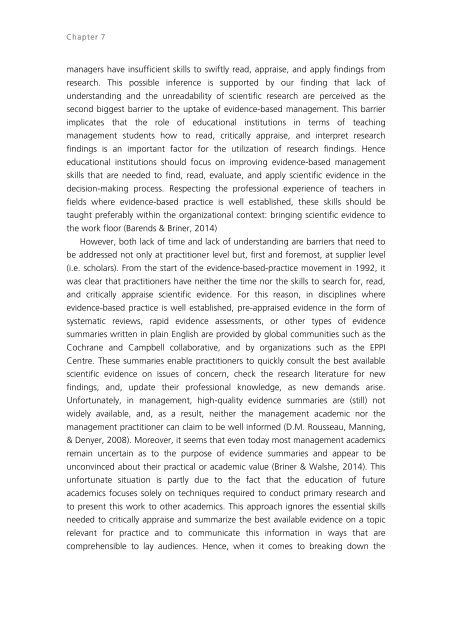In Search of Evidence
jqluvth
jqluvth
You also want an ePaper? Increase the reach of your titles
YUMPU automatically turns print PDFs into web optimized ePapers that Google loves.
Chapter 7<br />
managers have insufficient skills to swiftly read, appraise, and apply findings from<br />
research. This possible inference is supported by our finding that lack <strong>of</strong><br />
understanding and the unreadability <strong>of</strong> scientific research are perceived as the<br />
second biggest barrier to the uptake <strong>of</strong> evidence-based management. This barrier<br />
implicates that the role <strong>of</strong> educational institutions in terms <strong>of</strong> teaching<br />
management students how to read, critically appraise, and interpret research<br />
findings is an important factor for the utilization <strong>of</strong> research findings. Hence<br />
educational institutions should focus on improving evidence-based management<br />
skills that are needed to find, read, evaluate, and apply scientific evidence in the<br />
decision-making process. Respecting the pr<strong>of</strong>essional experience <strong>of</strong> teachers in<br />
fields where evidence-based practice is well established, these skills should be<br />
taught preferably within the organizational context: bringing scientific evidence to<br />
the work floor (Barends & Briner, 2014)<br />
However, both lack <strong>of</strong> time and lack <strong>of</strong> understanding are barriers that need to<br />
be addressed not only at practitioner level but, first and foremost, at supplier level<br />
(i.e. scholars). From the start <strong>of</strong> the evidence-based-practice movement in 1992, it<br />
was clear that practitioners have neither the time nor the skills to search for, read,<br />
and critically appraise scientific evidence. For this reason, in disciplines where<br />
evidence-based practice is well established, pre-appraised evidence in the form <strong>of</strong><br />
systematic reviews, rapid evidence assessments, or other types <strong>of</strong> evidence<br />
summaries written in plain English are provided by global communities such as the<br />
Cochrane and Campbell collaborative, and by organizations such as the EPPI<br />
Centre. These summaries enable practitioners to quickly consult the best available<br />
scientific evidence on issues <strong>of</strong> concern, check the research literature for new<br />
findings, and, update their pr<strong>of</strong>essional knowledge, as new demands arise.<br />
Unfortunately, in management, high-quality evidence summaries are (still) not<br />
widely available, and, as a result, neither the management academic nor the<br />
management practitioner can claim to be well informed (D.M. Rousseau, Manning,<br />
& Denyer, 2008). Moreover, it seems that even today most management academics<br />
remain uncertain as to the purpose <strong>of</strong> evidence summaries and appear to be<br />
unconvinced about their practical or academic value (Briner & Walshe, 2014). This<br />
unfortunate situation is partly due to the fact that the education <strong>of</strong> future<br />
academics focuses solely on techniques required to conduct primary research and<br />
to present this work to other academics. This approach ignores the essential skills<br />
needed to critically appraise and summarize the best available evidence on a topic<br />
relevant for practice and to communicate this information in ways that are<br />
comprehensible to lay audiences. Hence, when it comes to breaking down the


